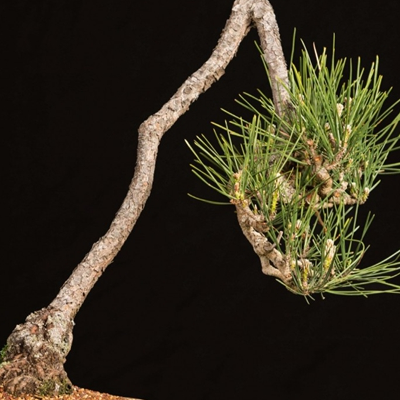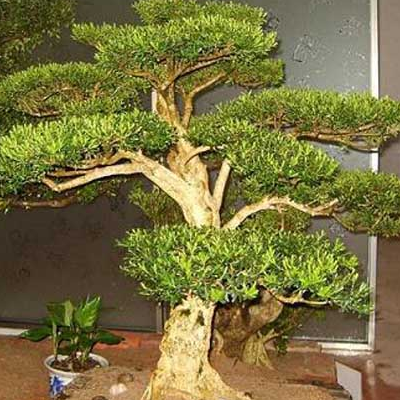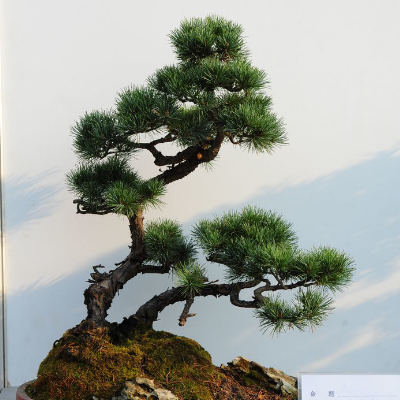How much is the maintenance method of black pine bonsai?
Black pine bonsai, this is a kind of bonsai that many people like breeding, that shape is also super good-looking, what is the conservation method of black pine bonsai? What is the price of black pine bonsai:

Maintenance methods of black pine bonsai:
(1) Environment
Black pine is a cold-resistant and drought-tolerant plant, which can be placed in a place with sufficient light and air flow. When raising small black pines, avoid exposure to the sun for a long time. In winter, the indoor temperature of black pine should not be too high, it can be placed in the open air to survive the winter.
(2) watering
In the maintenance of black pine, watering can not be excessive, wait until the black pine soil is dry to be suitable for watering, watering should be thoroughly. During the growth period of black pine, water control should be carried out properly, so that the branches can become thicker and shorter and have more ornamental value.
(3) pruning
During the breeding period, black pine needs to be pruned regularly in order to maintain its beautiful shape. The pruning work is mainly to pick the buds, and the new buds are removed every year from March to April, which can leave some of them to continue to grow and make the black pine more luxuriant. If you do not need to continue to grow branches, you can pick them all.
(4) fertilization
Black pine is a kind of barren plant, and the soil can grow and survive normally without nutrition, making its branches thick and short, needles short, and its shape more beautiful. However, it can be fertilized properly, which is more beneficial to its health and can prevent diseases and insect pests.
Price of black pine bonsai:
As a popular potted tree species in the current market, the price of black pine varies according to its shape and size. Generally, the price of large black pine bonsai with good shape is about thousands to 10,000, and if it is small, the price of thin branches is about dozens to hundreds.
The maintenance method and price of black pine bonsai are introduced here, so hurry up to give your family a plant to please the eye.
Maintenance method of black pine bonsai
The main results are as follows: (1) Environmental black pine belongs to cold-resistant and drought-tolerant plants, which can be placed in a place with sufficient light and air flow, and avoid exposure to sunlight for a long time when raising small black pine. In winter, the indoor temperature of black pine should not be too high, it can be placed in the open air to survive the winter. (2) in the maintenance of black pine, watering should not be excessive. It is not suitable for watering until the black pine soil is dry, and it should be watered thoroughly when watering. During the growth period of black pine, water control should be carried out properly, so that the branches can become thicker and shorter and have more ornamental value. (3) pruning black pine needs to be pruned regularly in order to keep its beautiful shape during the culture period. The pruning work is mainly to pick the buds, and the new buds are removed every year from March to April, which can leave some of them to continue to grow and make the black pine more luxuriant. If you do not need to continue to grow branches, you can pick them all. (4) fertilization black pine is a kind of barren plant, and the soil can grow and survive normally without nutrition, which makes its branches thick and short, needles short, and its shape more beautiful. However, it can be fertilized properly, which is more beneficial to its health and can prevent diseases and insect pests.
Production of black pine bonsai maintenance of black pine bonsai
Black pine is an evergreen tree of Pinus, native to Japan and the coastal areas of southern Korea. It is suitable for growing in warm and humic marine climate areas. It is not only an excellent plant for potted plants, but also an excellent seedling for landscaping. Let's take a look at the production and maintenance of black pine bonsai.
Application of Black Pine Bonsai
Black pine bonsai has a strong ability to adapt to the environment, courtyard and balcony can be cultivated. Its branches spread horizontally, the crown is like an umbrella cover, the needles are dark green, the four seasons are evergreen, and the tree posture is quaint and elegant, which can be appreciated all the year round. During the growth period, it should be placed outside where there is plenty of sunshine and air flow, and should not be placed indoors for a long time. The black pine pile scene, which has been cultivated for many years, is always vigorous and Qiu qu, with intertwined roots, showing the strange posture and indomitable vitality of the dragon's style, which is a good product for the family to cultivate and watch.
The habit of black pine bonsai
Black pine multi-purpose seed seedling propagation, the germination rate is high, up to 85%, the seedling growth is exuberant. The seeds were harvested in the middle and late October, exposed to sun and threshed, cleaned by the wind and stored in bags for the winter. Spring sowing should be early, and the slightly acidic soil with loose soil and good drainage should be used in the nursery, combined with soil preparation, sufficient base fertilizer, and soil disinfection. Soak the seeds in 0.5% potassium permanganate solution for 2 hours before sowing, then soak in 60 ℃ warm water for one day and night (natural cooling). Remove and spread out in a warm place, sprinkle with water once or twice a day, and sow seeds after a week. It began to sprout and unearthed in the middle and last ten days of April, and can come out in 10 days, and the seedlings of that year can be as high as 10-15 cm. Potted plants can be planted with 2-or 3-year-old stout saplings and then processed and modeled.
Production of black pine bonsai
1. When mining, the mining face should be expanded, and attention should be paid to carrying as much soil as possible. Because black pine grows in the sand and gravel soil on the hillside, the soil is less, and the weather is dry in winter, and the soil contains less water and poor stickiness, so it is necessary to protect the root soil as much as possible when mining. Because the root soil is rich in root mold, it is a symbiotic fungus of Pinus koraiensis, which is very conducive to root growth. After excavation, plastic bags should be used to make simple bandage in time to prevent soil loss during handling and facilitate transplanting.
2. When digging, we should pay attention to protect the root system of black pine, start digging a little farther away from the pine tree, first dig out the surrounding soil, keep the main root as much as possible, cut off the root smoothly, cut off the rotten root, and avoid damaging the root system as far as possible. Especially the lateral root and fibrous root of black pine in sand and gravel, the root system is weak, stay as long as possible, and should be protected especially when digging.
3. The black pine dug back should be buried in time, and the faster the better, the longer the time will cause the root to lose water and dry up, which will affect the survival. In order to prevent the roots from being buried too deep, we can take high planting and shallow planting, and then add soil to cover it. Those who have no conditions to cultivate in the field should be pots in time.
4. The upper basin of black pine is very important. Before cultivation, gravel and tiles of the basin bottom cushion are first used to facilitate ventilation and drainage, and then fill the surrounding area with soil. The gap in the soil is too large, it is easy to cause frozen roots, the basin is covered with grass curtain to prevent freezing. The original soil on the mountain is the best for the soil, and the mixture of coarse yellow sand, coal ash and yellow mud can also be used, and the proportion is 0.5-0.25-0.25. It should be fortified in time after potting, too many branches and leaves will affect the insufficient water supply of roots and consume a lot of water and nutrition.
Maintenance of black pine bonsai
1. Environment: black pine is cold-resistant and drought-resistant, and can be placed on the courtyard slope and balcony all the year round, where the light is sufficient and the air flows. However, small bonsai should not be exposed to strong light at the height of summer. Winter can be overwintered in the open field, it is best to bury the basin in the sunny leeward place. If you spend the winter indoors, the room temperature should not be too high, Ching Ming Festival can move to the outside.
2, watering: black pine likes to dry and avoid stagnant water, watering should not be excessive, only when it is dry, it will be watered thoroughly. Proper water control during the growing period can make the branches thick and short, the needles short, and increase the ornamental value. When it is hot in summer, foliar water can be sprayed frequently, which is beneficial to growth.
3. Fertilization: black pine is resistant to barren, the soil is short of fertilizer, can also grow normally, and promote short stem, dense branches and short leaves. However, the proper application of thin and rotten cake fertilizer and water during the growing period is beneficial to robust growth and increase the ability of resistance to diseases and insect pests.
4. Pruning: in order to maintain its graceful and quaint tree shape, the bonsai of black pine should be pruned properly. During the growing period, the main pruning is to pick buds, 3 to 4 evenly every year. When the new buds elongate but have not yet produced needles, you can remove about 1 / 2 of each top bud. If you do not need bonsai to grow branches, you can pick all the terminal buds. The branches that affect the appearance of the tree can be pruned during the dormant period.
5. Turn the basin: the black pine bonsai is usually turned once every 3 to 5 years, and it is suitable to be carried out from February to March. When turning the basin, it is necessary to keep the original basin soil intact, remove 1 inch and 2 old soil, cut off overgrown roots, as well as withered and rotten roots, and trim some unnecessary branches and leaves to maintain the balance between the upper and lower parts of the basin soil. If the capacity of the original basin is not enough, it can be replaced with a slightly larger new basin, and the planting method is the same as that of the upper basin.
- Prev

What is the price of the maintenance method of boxwood bonsai?
Poplar bonsai, this kind of bonsai is really good-looking, people like it so much that they don't want it, what is the maintenance method of boxwood bonsai? How much is the price of boxwood bonsai: the maintenance method of boxwood bonsai: 1. Watering the poplar bonsai is different from the general plant maintenance without drying or watering, but the principle of thoroughly watering is different.
- Next

How much is the bonsai cultivation technique of Luohansong?
Luohan pine bonsai, this is a lot of people like, originally Luohan pine bonsai has so many shapes, what is the cultivation technology of Luohan pine bonsai? How much is Luohan pine bonsai: cultivation techniques of Luohan pine bonsai: (1) Environment: Luohan pine is a subtropical tree species, which produces in the Yangtze River basin and other provinces and regions in the south. Like half yin
Related
- Fuxing push coffee new agricultural production and marketing class: lack of small-scale processing plants
- Jujube rice field leisure farm deep ploughing Yilan for five years to create a space for organic food and play
- Nongyu Farm-A trial of organic papaya for brave women with advanced technology
- Four points for attention in the prevention and control of diseases and insect pests of edible fungi
- How to add nutrient solution to Edible Fungi
- Is there any good way to control edible fungus mites?
- Open Inoculation Technology of Edible Fungi
- Is there any clever way to use fertilizer for edible fungus in winter?
- What agents are used to kill the pathogens of edible fungi in the mushroom shed?
- Rapid drying of Edible Fungi

